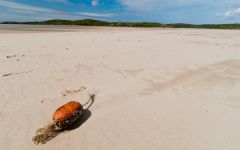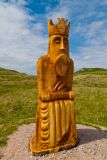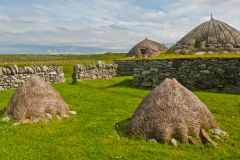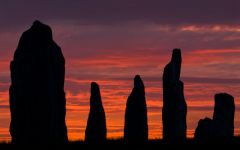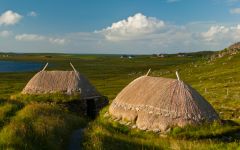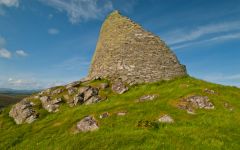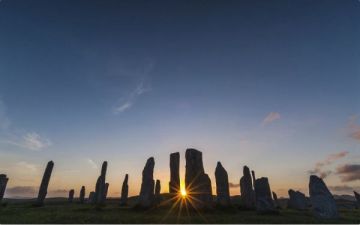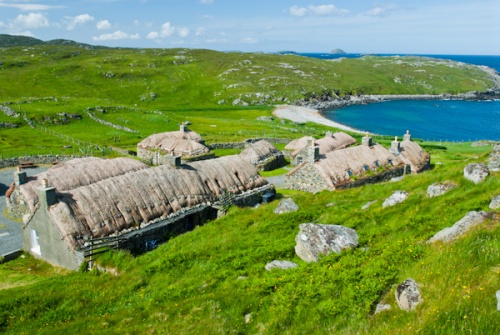
Counting Lewis and Harris as two separate islands is a bit misleading; they are actually two parts of the same island, but each has its own unique character.
Much of that character is formed by the geology of the landscape; in the north, Lewis is largely peat moorland, with few hills. The peat deposits of the large plain of central Lewis is still an important source of fuel for islanders, and it is a common site to see stacks of peat drying in long rows across the moors.
By contrast, central Harris resembles nothing so much as an otherworldly lunar landscape in places; a region of startling scenery shaped by ancient glaciers. The west coast of both islands is famous for white, sandy beaches, which stretch for miles along quiet coves.
Lewis and Harris were settled gradually by Viking raiders beginning in the 9th century, and from the 9th to the 11th century they were controlled by Clan MacNicol.
Lewis
The islands were settled in prehistoric times, and the ancient islanders left indelible reminders of their presence. The most obvious reminder is the astonishing alignment of standing stones at Callanish, justly famous as one of the most impressive ancient monuments in the world.
I've watched the sun rise and set over the stones at Callanish, and I can say, hand on heart, that being there provided me with the most extraordinary experience of all the historic places I've visited in the UK. Of course, it helps if you get up at 3am and are lucky enough to see a sky painted red with dawn colours more vivid than anything Rembrandt ever imagined!
Though Callanish gets most of the attention, and rightly so, for it truly is an amazing site, there are other prehistoric monuments on Lewis, including smaller circles at Steinacleit, and a huge solitary standing stone at Truiseil. Even more impressive is the Iron Age broch at Carloway, one of the best-preserved brochs in the country.
The heritage of island lifestyle is preserved at two major sites; the Arnol Blackhouse and Garenin Blackhouse Village. As you might guess from the name, Arnol is a single traditional cottage, or blackhouse, while Garenin is an entire village that was inhabited until relatively late in the 20th century and has now been restored. Both sites give an intriguing glimpse into the traditional lifestyle enjoyed - if enjoyed is the right word - over the centuries. A more ancient dwelling is a Bostadh, where an Iron Age hut was discovered buried in the sand.
Odd Places to See on Lewis
One of the more unusual visitor attractions on Lewis is at Bragar, where you will see an arch made from whalebones, set upright. Another is the so-called Bridge to Nowhere, north of Stornoway, all that remains of an abortive attempt by Lord Leverhulme to build a road around the northern end of the island.
East of Stornaway, on the peninsula called Point, stands a 14th-century disused church dedicated to St Columba. Nineteen chiefs of Clan MacLeod are buried in the graveyard.
At Europie stands St Moluag's Church, built in the 12th century and known as a centre for healing. It was thought that people could be cured of mental illness if they slept in the church overnight.
Along the A859 road from Stornoway to Tarbert is a memorial to men of Paircs, in the Lochs region, who were arrested and tried for poaching deer in 1887. Their case helped raise public awareness of the plight of crofters in the Highlands and the terrible conditions they were subject to.
Isle of Harris
Perhaps the most important historic site on Harris is at the southeastern tip of the island, at Rodel. Here you will find the medieval church of St Clement, in an exposed position looking out to sea. Within this extraordinary medieval building is a series of carved tombs to MacLeod lords, including the founder of the church, Alisdair Crotach (Alisdair the Hunchback).
Just up the coast from Rodel is Leverburgh, once a centre for the herring fishery and now the terminus for the ferry service to Berneray, giving access to all the Uists.
The west coast of Harris is famous for its beautiful beaches, but there is history here, too. At Borve is a standing stone and dun, and near Loch Leosavay is a Victorian-era castle built by the Earl of Dunmore.
By contrast with the wide, sandy bays and beaches of West Harris, the east coast is a tangled maze of twisting, rocky inlets and astonishing scenery known as the Bays.
Small fishing villages and hamlets are linked by the so-called Golden Road, between Tarbert and Rodel. As you might guess from the name, the Golden Road cost a lot of money to build, which is not surprising when you drive it; the road twists and turns, and rises and falls more frequently than a fairground rollercoaster. But, oh, the scenery!
We enjoyed:
